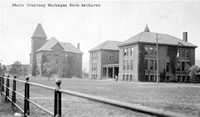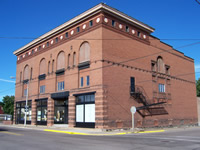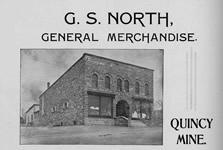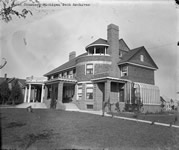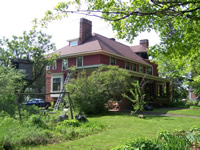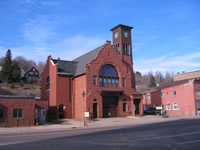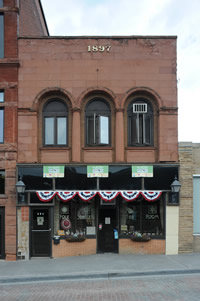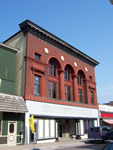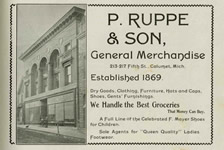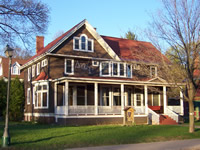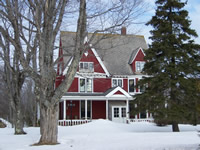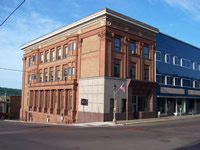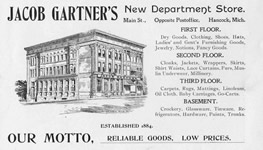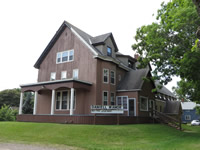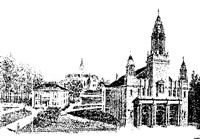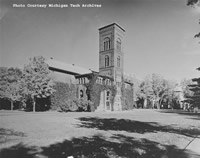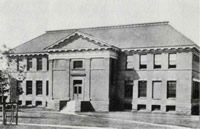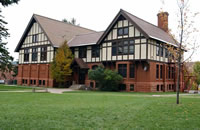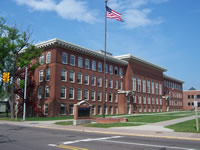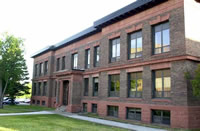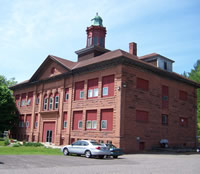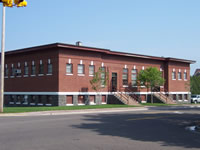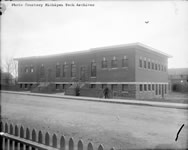Buildings by Charlton & Gilbert (1891-95)
Michigan Mining School (Michigan Technological University), Engineering Building (Mechanical Engineering Building, Shops Building, Materials Processing Laboratory) Charlton & Gilbert designed the second building on the college’s campus, a two-story, hip-roofed structure laid out in a U shape with the wings projecting forward. Between them was a one-story porch that supported a polygonal oriel at the second level. The rather severe building had brick walls and sandstone trim, with a modest modillioned cornice. It was constructed at a cost of $30,000.2 J. Vivian, Jr. & Co. Building Johnson Vivian, a Cornish mining captain with diverse commercial interests, brought his son, Johnson Vivian, Jr., into the mercantile business when he established a store in Osceola in 1886. In 1894 they established a branch in Laurium. The store was immediately successful and spurred other commercial development on Hecla Street. By 1895 J. Vivian, Jr., & Co. offered a wide range of dry goods and had more than fifty employees.3 By 1903 the store was reportedly the largest in the Copper Country.4 The store closed in 1936. The original building, as designed by Charlton & Gilbert, was two stories tall, three bays wide, measuring 58’ x 90’. In 1898 Johnson contracted with Charlton, Gilbert & Demar to design an additional third story. In 1906 the Maass Brothers designed another addition, the northern bay, so the building currently measures 90’ across the front. A one-story rear addition in 1974 further increased the space.5 The Italian Renaissance Revival building now has four two-story round-arched windows and a modillioned cornice with attic windows, alternating with marble medallions, in the frieze. The building is brick, with some sandstone trim. At the first level, large plate-glass display windows are divided by piers of alternating courses of brick and rough-faced sandstone. The side elevations have Palladian windows at the third floor.
Buildings by Demar & Lovejoy (1891-1895)Seth D. North & Son Store This building was a two-story store constructed of variegated Jacobsville sandstone. Paired plate-glass windows flanked the round-arched center entrance. Round-arched windows illuminated the second floor. The building had no cornice. Quincy Mining Company built a store and operated it in 1863-64, but lost money on the venture and sold it to Seth D. North in September 1866. North operated a successful venture for several decades. The store was demolished for construction of the new Quincy office building in 1895, so Quincy built this new store and leased it to North.6
Buildings by Charlton, Gilbert, and Demar (1895-1901)Vivian House This Shingle Style house has a Jacobsville sandstone first floor and the distinguishing shingles on the second floor. Numerous porches and porticos project, including a squat round tower at one corner and a porte cochere on the opposite side. The semicircular portico has been removed. Johnson Vivian, Jr., was a prominent merchant, banker, and industrialist.
Hancock Town Hall and Fire Hall (Hancock City Hall) In February 1898, three architectural firms submitted plans for this commission: William T. Pryor, C. Archibald Pearce, and Charlton, Gilbert & Demar. The latter firm was selected, and the building was dedicated on February 16, 1899, having been constructed at a cost of $15,000. The newspaper lauded the building:
The first floor accommodated the fire department, and the second floor housed the clerk’s office and council chambers. Also on the second floor was the firemen’s assembly hall,
The building was distinguished by a 90’-high corner tower, used for drying fire hoses as well as displaying the town clock. The rough-faced sandstone building had a broad front with a Flemish gable. At the second level, a large round-arched window illuminated the council chamber. Hancock became a city in 1903.
Kroll Block Although this building bears the date “1897” on its front, Eckert dates it to 1899-1900 and credits it to Charlton, Gilbert & Demar.9 The two-story building has had its cornice removed and its first floor altered, but the second floor exhibits three graceful round-arched windows separated by engaged fluted columns. The wall is a smooth-faced Jacobsville sandstone. The building housed druggists from 1897 until 2000.10 Ruppe Block P. Ruppe & Son undertook $12,000 worth of renovations to a two-story frame building to produce this handsome commercial block for their store. As reported in the newspaper, “An entire new front of pressed brick and terra cotta from foundation to roof has been built, a third story has been added, and the store throughout entirely renovated.”11 In addition, “Contractor Ed Ulseth says it will be the ‘swellest’ front in the city.”12 The 57’ x 100’ building has a brick front trimmed with terra cotta. Three two-story round-arched windows are separated by fluted columns. Marble roundels decorate the wall above the arches. A modillioned cornice tops the façade.
John Rees House John L. Rees, assistant cashier at the National Bank of Houghton, commissioned this two-and-a-half-story building with shingle-clad walls and a porch across the front. A slightly projecting two-story bay window on the front, and a one-story one on the side, add to the visual interest. The cross-gable roof has a Palladian window in the front gable. When it was built, the newspaper said it was “not an extremely large house, but it is thoroughly modern in every particular.” The shingled walls were painted dark brown, the trim a cream color, and the roof green. The house had five bedrooms and a bathroom, with servants’ rooms in the attic. The house had both electric lights and gas and, according to the paper, Rees planned to put a gas engine in his yard to make his own gas. The house cost $6,000 to build with another $1,000 for landscaping and outbuildings.13 By 1903, Rees had moved to Cleveland and sold the house to Nellie P. Douglass, who lived there with her husband, Courtney C. Douglass. Courtney Douglass, son of Columbus C. Douglass, handled his father’s real estate holdings, but this house remained the property of his wife. By 1928 it was the home and office of Dr. Alfred Labine until his death in the late 1960s. Since 1991 it has been the home of Delta Phi Epsilon sorority.14
Wolverine Copper Company Superintendent's House The Wolverine Copper Company was established in 1882. In 1898 John Stanton established Mohawk Mining Company five miles to the north and also gained control of the Wolverine. Fred Smith had been superintendent of the Wolverine since about 1892 and, when he was also assigned to supervise the Mohawk, the company built this house for him at a cost of nearly $12,000. After Smith’s retirement in 1913, Theodore Dengler, the new superintendent of both mining companies, occupied this house. After closure of the mines in 1932, Dengler bought the house from the company, reportedly for $22.50. Dengler committed suicide in the house in 1940.15 The house is a large Queen Anne-style mansion with porches, bay windows, a lively roofline, and diamond-paned windows. The front of the side-gable roof is pierced by two gabled dormers of different sizes. The wood-frame house has clapboards on the first floor and wood shingles above; the foundation is rough-faced Jacobsville sandstone. The interior, in an irregular L-shaped plan, is finely finished. St. Anne’s Church (Keweenaw Heritage Center) Designed in 1899 and completed in 1901, this church was constructed for Calumet’s French Canadian population. Designed in the Gothic Revival style, the church was built of rough-faced Jacobsville sandstone. The most prominent feature is the corner bell tower which rises to a height of 130’. The church was built on a 5’-high water table and is accessed through a triple Gothic-arched entrances. Along the sides pointed-arched windows are separated by buttresses. The interior of the church held up to 800 congregants and is lined with 14 stained-glass windows of purple, brown, and green. No longer a church, the building’s pews and main altar were removed, but the dramatic interior remains.
Wright Block Completed in 1900, this building was divided into two, with the east side containing Superior Savings bank and the west being the home of Gartner’s department store. The Classical Revival building is clad in buff brick and ornamented with smooth-faced Jacobsville sandstone. The Quincy Street front of the building has been compromised with alterations at the first floor, but the two stories above have two-story pilasters and a handsome modillioned cornice. On the Reservation Street side, a colonnade runs along the first floor, supporting two-story oriels at either end. Although Gartner’s apparently hoped to occupy the whole building, the dry-goods firm initially shared it with the Superior Savings Bank. In 1907 Gartner’s added a three-story building to the west, designed by H. T. Liebert and built by Erik Anderson. This and half of the Wright Block’s facade were covered by a new façade of blue Vitrolite in 1952.16
James R. and Virginia Cooper House James R. Cooper, head of the Detroit & Lake Superior Smelter Company, also designed Quincy’s new smelter in 1898 and was superintendent from 1898-1906. Apparently, housing was part of that arrangement, because in 1900 Quincy gave him $7,000 to underwrite the cost of his new house. The house belonged to Quincy, though; Cooper leased it back from the company for $350 a year.17 Charlton, Gilbert & Demar designed a house that was large in size but modest in style. The two-and-a-half-story, wood-frame house had narrow clapboard siding, a Portage Entry sandstone foundation, and a porch on two sides. The porch had Ionic columns and turned balusters. The front of the house had a two-story bay window; the door was on the side of the house. Paired Corinthian columns decorated one of the three gable dormers on the side-gable roof. The first floor included a parlor, sitting room, dining room, library, coat room, and various service spaces, while the second floor had six bedrooms, a linen closet, and a bath room. Two bedrooms and a sitting room, along with an unfinished store room, occupied the attic. The specifications noted that “All material used to be the best of their respective kinds, and the work to be done in the very best style of workmanship, and to be done under the direct supervision of the Architects.”18 James Cooper died in 1906. In 1917 the building became a Finnish hospital. In 1931 it accommodated a restaurant known as the Italian Gardens, which was destroyed by fire. A newer house now sits on the site.19 Susan Daniell House This grand house was built for Susan Daniell, widow of mine captain John Daniell. Susan Edwards, born in England in 1849, immigrated to the Copper Country as a child. She married John Daniell in 1869. They lived at Copper Falls until 1876, when Daniell became head of the Osceola Mine. In the early 1880s, he spearheaded the development of the very successful Tamarack Mine. Daniell died in 1898.20 The Daniells had eight children, seven of whom were living at home when Susan undertook construction of this new house. The children were: Alice, age 28 in 1900, at home; John, 26, a civil engineer who went on to become president of the Wolverine and Arizona Mining Company and a vice-president of the Calumet Gas Company; Richard E., 24, a clerk in a mine office; Anna, 22, at home; Edwina, also known as Winnie, 18, at home; William, 17, at school; and Marian, 13, at school. By 1910 her oldest son, Joshua, an artist, had moved back home. By 1920, besides Joshua the only other child living at home was Marian, along with her husband, a dental surgeon named Carrol W. Pratt.21 The Colonial Revival-style house stood two-and-a-half stories tall with a side-gable roof. Two-story bay windows flanked the central doorway. Gable dormers flanked a shed-roofed dormer. A porch across the front and a porch across the side were both crowned with balusters. In the 1970s, when the building served as a home for the elderly, a large two-story addition with a yellow-brick first story was built on the south side. Probably at the same time a large gable-roofed entrance was added to the front and the whole of the original building covered with vertical wood siding.
John C. Donahue House John C. Donahue, a painter, commissioned this house in 1900 at an estimated cost of $6,000. The two-and-a-half-story house had a circular veranda, since removed, across the front, and several bay and oriel windows. The broad hip roof has hip-roofed dormers. The first floor had "a large parlor, sitting room, dining room and kitchen beside a wide hall from which a winding stair leads to the second floor," while the second floor had three bedrooms. The house had all the contemporary amenities, such as electric lights, along with piping for gas "in case the electric lights do not prove satisfactory"; a bathroom and linen closet on the second floor; servants’ rooms and “a spare room for drying clothes” in the attic; and laundry, vegetable, and fuel rooms in the basement. Ten-foot-high ceilings on the first floor and nine-foot-high ceilings on the second floor added to the sense of spaciousness. As befitting a house for a decorative painter, "all the walls and ceilings are to be tinted in delicate shades to correspond with the woodwork," which was quarter-sawn oak on the first floor and pine on the second.22 Donahue lived here until after 1917.
St. Joseph’s Church Completed 1912 with modified design, A. F. Wasielewski, architect By 1897 the French Canadian congregation of St. Joseph's Roman Catholic Church had outgrown its 1871 church building, so it decided to build a new stone church at the same location. Charlton, Gilbert & Demar, with C. A. Pearce, Associate Architect, produced working drawings in August 1901, although detail drawings from a few months later had the title block of Charlton & Gilbert, along with Pearce.23 By January 1902 the lower level of the new church was completed, but construction on the new building halted for lack of funds. Mass was held in the basement of the church until enough money was raised to complete construction.24 Architect A. F. Wasielewski modified the design and the building was completed in 1912. Charlton, Gilbert & Demar’s design called for a Jacobsville sandstone building with a strong central tower, flanked by two subsidiary towers at the corners. The three-part entrance was framed with Ionic columns surmounted by a cornice. In the original design, the church faced Front Street, the main street in Lake Linden. But by 1912 the main street had shifted one block west to Calumet St., so Wasielewski reoriented the church to face the new main street. Buildings by Charlton & Gilbert (1901-03)
Michigan Mining School (Michigan Technological University), Mining Engineering Building (Sperr Hall) In 1901 Michigan Mining School received funding for two additional buildings. The mining engineering building, built at a cost of $28,880, was a two-story hip-roofed structure with a five-story tower centered on the front. The brick building had a high sandstone basement and a number of round-arched windows, adding to the Italian Renaissance Revival feel.25
Michigan Mining School (Michigan Technological University), Chemistry Building (Koenig Hall) Built at a cost of $23,500, the Chemistry building was more modest in design. The two-story brick building had a hipped roof and modillioned cornice. The center three-bay section projected and was topped by a pediment.26
Hall Building (Citizens National Bank Building) Charles Archibald Pearce, briefly associated with Charlton & Gilbert, was also linked to the design of this building. The three-story Classical Revival building was clad in brick, trimmed with Jacobsville sandstone. The paired entrance is centered, with storefronts to either side. Prism-glass transom windows were removed in recent years. The west doorway leads to the upper floors, which have paired windows. The third-floor windows have additional transom windows and a tall frieze, indicating the extra height of this floor. The building is crowned with wide overhanging eaves. The building was named after its major investor, E. R. Hall of Chicago. Construction cost $40,000. Citizens National Bank occupied the eastern half of the first floor, and the Chicago Store, selling clothing, occupied the western half. The second floor accommodated offices, while the third floor was a lodge hall, which the newspaper called “one of the most beautifully decorated in the peninsula.”27 Buildings by Charlton & Kuenzli (1904-17)
Michigan College of Mines (Michigan Technological University), Gymnasium and Clubhouse (ROTC Building) This building, the oldest remaining on campus, was built as the gymnasium and clubhouse in 1904-06. In 1902, the faculty pledged to donate $1,700 toward the new building and the students raised it to $5,000. When the fund reached $18,500, construction began. The gymnasium doubled as an assembly hall, and graduation ceremonies were held here. Currently, it is home to Michigan Tech’s ROTC program.28 The Tudor Revival-style building has a Jacobsville sandstone foundation, brick first floor, and half-timbered upper stories. Two gable-fronted sections project, while the lower center section has a side-gable roof. A bay window, buttresses, and door hood add to the liveliness of the building. Inside, the gymnasium occupies the large section on the west. The suspended wooden running track survives. The section on the east was used as the clubhouse, predecessor to the student union. A large fireplace at one end created a club-like feel.
Calumet Manual Training and High School (CLK High School) In 1905, Calumet’s Manual Training and High Schools, which were owned by the Calumet & Hecla Mining Company and leased to the school district, burned to the ground. C&H hired Charlton & Kuenzli to design the replacement, in which the two schools were combined. The three-story brick building was 272’ long, with ranks of segmental-arched windows. The center section, which projected on both sides, contained an assembly hall at the second level. The building is plain, according to C&H President Alexander Agassiz’s wishes. He wrote to General Manager James MacNaughton, “Give up all cornice work and don’t let us spend any money on looks. We want first of all a serviceable Bldg., and architecture has no claim whatever on us.”29 Nonetheless, the building does have a modillioned cornice.
Michigan College of Mines (Michigan Technological University), Administration and Library Building (Academic Office Building) This building was constructed to house the library, administrative offices, and mineral museum. Currently it is the home of the Department of Social Sciences, School of Business and Economics, and the Department of Education. The Classical Revival-style building is clad in a dark brick. Jacobsville sandstone is used for the prominent foundation, lintels, frieze, and one-story portico. The three bays at either end of the building project slightly. The L-shaped building housed the library stacks in the rear wing.
Ripley School This two-story, Jacobsville sandstone school has a Classical Revival appearance. A central pediment is supported by four smooth-faced sandstone pilasters. The cornice has modillions and dentils. Above the doorway are three round-arched windows. The broad hip roof is crowned by a cupola. The sandstone walls are rough-faced, contrasting with the pilasters and central doorway and window surrounds. The large windows have been unfortunately filled in. The building is currently divided into twelve apartments. The original wood flooring, staircase, and some school equipment, such as a wall-length chalkboard and coat hooks, remain in the halls. Calumet & Hecla Bathhouse The popularity of the bathtubs and showers that Calumet & Hecla had built in the basement of the library necessitated the construction of a bathhouse soon after. The $45,000 building was one story on a raised basement and accommodated bathtubs for women, bathtubs and showers for men, and a 26’ x 40’ swimming pool. Women and children used the bathhouse for free, while men paid 3 cents and boys 2-1/2 cents. C&H underwrote the cost of the bathhouse operations at more than $7,000 a year. The bathhouse is modestly decorated. The three bays at either end projected, and had small, high windows reflecting the bath and locker rooms within. The swimming pool was in a rear wing. The brick building was placed on a stone foundation. Keystones over the windows, the flat roof, and the symmetrical layout contributed to the Classical Revival appearance.
Buildings by Herbst & Kuenzli
Michigan College of Mines (Michigan Technological University), Chemistry Building (Koenig Hall) On March 4, 1920, a fire destroyed Koenig Hall, the chemistry building. A new building was needed quickly and inexpensively due to a large student body and a lack of many other buildings on campus. Plans were submitted by Herbst & Kuenzli of Milwaukee with assistance provided by D. Fred Charlton of Marquette. The structure would be placed on the old foundation of Koenig Hall because it was not severely damaged in the fire. The old foundation would also save money in construction; the probable cost of the building was $160,000. By December of 1920 walls were already completed on the new building. The main part was 114’ x 35’ with two wings, one of 53 ½’ x 35 ½’ and the other 16 ½’ x 35 ½’. The main chemistry lab was on the first floor and was larger than the old lab. The quantitative lab and qualitative lab retained their positions on the second floor. The new building also had two lecture rooms rather than one as in the first chemistry building. The new building was made of brick, reinforced concrete, and tile. There was also an extensive effort to create a sufficient air system which would remove harmful toxins from the building. The new building had a modillioned cornice and a flat roof.
|



